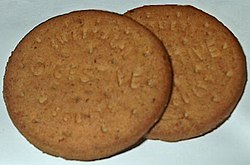Chocolate digestive
 |
|
| Alternative names | Wheaten, sweet-meal biscuit |
|---|---|
| Type | Biscuit |
| Place of origin | Scotland |
| Main ingredients | Wheat flour, sugar, malt extract, vegetable oil, wholemeal, raising agents (usually sodium bicarbonate, tartaric acid and malic acid), salt |
| |
|
A digestive biscuit, sometimes described as a sweet-meal biscuit, is a semi-sweet biscuit that originated in the United Kingdom and is popular worldwide. The digestive was first developed in 1839 by two Scottish doctors to aid digestion. The term "digestive" is derived from the belief that they had antacid properties due to the use of sodium bicarbonate when they were first developed. Historically, some producers used diastatic malt extract to "digest" some of the starch that existed in flour prior to baking.
First manufactured in 1892, McVitie's digestive is the best selling biscuit in the UK. A prominent feature in British culture, the digestive is ranked the most popular biscuit for "dunking" into tea.
In 1839, digestives were first developed in the United Kingdom by two Scottish doctors to aid digestion. Digestives featured in advertisements for the Berkshire-based biscuit company Huntley & Palmers in 1876, with a recipe being given in Cassell's "New Universal Cookery Book" of 1894. In 1851 an issue of The Lancet London's advertising section offered brown meal digestive biscuits. At the time, it was asserted grain millers knew only of bran and endosperm. After 10% of the whole grain's coarser outer-bran coat was removed, and because the innermost 70% of pure endosperm was reserved for other uses, brown meal, representing only 20% of the whole grain, remained, consisting of about 15% fine bran and 85% white flour. By 1912 it was more widely known that brown meal included the germ, which lent a characteristic sweetness.
In 1889, John Montgomerie of Scotland filed a U.S. patent application, which was granted in 1890. This patent asserted a prior patent existed in England dated 1886. The U.S. patent, titled "Making Malted Bread", included instructions for the manufacture of digestive biscuits. Montgomerie claimed this saccharification process would make "nourishing food for people of weak digestion".
...
Wikipedia
